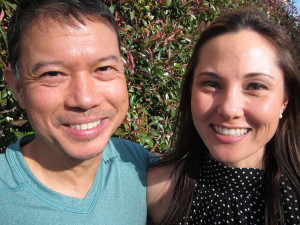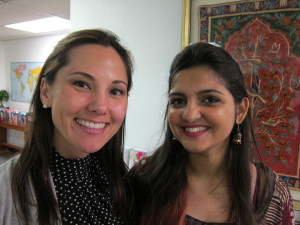
By Sharon Simonson
SAN JOSE—Alicia Forbrich stands on a small patch of grass to the side of the two-story, cream-colored building in downtown San Jose that houses her multi-language school, a yoga studio and a jiu-jitsu academy. To celebrate her school’s four-year anniversary, the 33-year-old daughter of an East German father and a Japanese mother hired Hawaiian muralist Kaiili Kaulukukui to create an expression of her world outlook. Hong Kong’s Big Buddha now gazes serenely down San Carlos Street; Japan’s snowy Mt. Fuji rises above his left shoulder; China’s terracotta warriors march at his feet. Forbrich is pleased.
“I wanted (the mural) to show cultures from all around the world, to show everything blending together, and everyone getting along,” she says. “In Silicon Valley, you have so many cultures, but they segregate themselves. I’ve always wanted to bring cultures together.”

Her parents, who migrated to America after suffering deep hardships in their homelands, blanched four years ago when Forbrich left a promising job with a San Francisco international shipping-container distributor. Even as the global financial crisis cast its pall, she poured her life savings into a vision to create a place for intercultural communication, language instruction and learning, alongside the pursuit of physical fitness. (She exudes fantastic health.) She figured that at age 29, if the business failed, in five years she could return to the corporate world and still have a respectable career.
For her mom, who wanted Forbrich to be a lawyer, the school and education generally represented low social status and achievement. (Her sentiments have evolved.) Her dad—a prosthetist, or maker of prosthetics—always preferred she be a doctor. Instead, she earned an undergraduate degree in international business from the University of San Francisco and a master’s degree in business administration from San Jose State.
Her father, who has suffered from Parkinson’s disease for nearly two decades, owns the San Carlos Street building on the gentrifying, southwest edge of downtown San Jose. Forbrich remade the inside.
A man dressed in khaki shorts and a blue t-shirt approaches from the parking lot. William Cristobal is co-founder of Yoga Belly Studios, which has rented space in the San Carlos building since June 2013. The 48-year-old yogi expresses delight with the mural. He and Forbrich hug then pose for photos in front of it.
Cristobal and his husband, who opened their first yoga studio on Castro Street in trendy downtown Mountain View in July 2010, came to San Jose after a deal for a second Mountain View location unexpectedly fell through. “We were in a quandary,” Aaron Goodnow, Cristobal’s spouse, says later by telephone. “I said, ‘I think we need to take our vision out of Mountain View and go into a different setting — somewhere in the universe where I don’t have to spend a lot of money building up the space and that will open us to another market.’
“Literally, we got an email from Alicia the next day. She said, ‘I am looking for a fitness company,’ and we said, ‘Let’s go.’”
Sitting in one of her school’s small classrooms—classes are limited to 10 students—Forbrich describes how her father smuggled his vital documents out of East Germany by concealing them inside the cylinders of a bicycle frame when he was allowed to cross into democratic West Germany. Both parents have spent their American lives working—in their 70s they are still working—first to live, but then to help others, mostly fellow immigrants and life’s downtrodden. Her father, the prosthetist, “When he sees someone without a body part, he just wants to fix them,” Forbrich says. Her mother makes hairpieces. “Her heart goes out to people who are losing their hair. It’s not just people’s hair, it’s their confidence.”
My parents, she says, have “big, open hearts.”
A man with strawberry blond hair in his early 30s or late 20s ascends the stairway to the second level of the San Carlos Street building where language classes are held. “I still wanted to sign up,” he tells Forbrich.
“How is your wife?” she responds.
“She is doing good. She had a fever, but it is getting a lot better,” he says.
“That is pretty scary when you have to drive someone to the emergency,” Forbrich says. “So I will still do the 10 percent — ”
“Actually 50 percent works a lot better for me,” he jokes.
“I wish I could!” Forbrich says.
The man apologizes for appearing disheveled. “I just did a jiu-jitsu class.”
“When I have kids, especially girls, they are going straight into jiu-jitsu. Even if you are a tiny female, you can still get the other guy, no matter how tall and strong he is,” Forbrich says.

Matt Darcy, the 32-year-old co-founder of Guerrilla, and his business partner, Dave Camarillo, also weren’t considering San Jose when they were deciding where to open a second location to their existing Pleasanton jiu-jitsu academy. “That space,” Darcy says, “kind of fell into our hands. Dave’s wife’s mom—her best friend knew about it.”
Besides Brazilian jiu-jitsu, where tournaments are staged in Portuguese, Guerrilla teaches judo, where Japanese is the lingua franca. “All three of the businesses are younger-generation people trying to become successful. We want to bring everyone up with us and be positive influential members of society,” Darcy says. Guerrilla Jiu-Jitsu students regularly attend language classes at Forbrich’s school.
Despite her parents’ skepticism, demand has blossomed for the language and culture instruction that the Learning Center offers, from Silicon Valley’s many immigrants wanting to learn American English and American ways but also from U.S. natives seeking an edge in global business or a language and culture primer in anticipation of foreign travel or simply new insight. The ebb and flow of interest in each language reflects not only local populations but world trends and events.
Several years ago Korean rose unexpectedly in popularity among teenagers and young adults, initially catching Forbrich off-guard, until she linked it to the international “K-Pop” (Korean pop music) obsession. Japanese classes are full of youthful anime enthusiasts. “When we had the World Cup in Brazil, suddenly the Portuguese classes picked up. Same with the Olympics in Russia,” Forbrich says.
Starting with seven language classes, the center now offers 65 group classes and more than 100 private lessons, teaching 18 languages including English and sign language. She also offers instruction in 3-D printing and web design as well as various computer languages. She employs 45 instructors part time.
But asked about her hopes for a decade from now, Forbrich’s shoulders unexpectedly fall, and she casts her eyes downward. Her father has recently told her that her success in business isn’t really enough, she confides. He wants her to focus somehow on charitable work—helping poor people, to be exact—either as an extension of her business or in an entirely different venture. The tension between pleasing her father and the sheer limit of time hangs in the air: how do you start and run a successful business, help your ailing father 30 hours a week including helping to run his business, and create a non-profit enterprise to help people less fortunate than you on the side? Clearly Forbrich isn’t sure, yet.
In the meanwhile, the mural brings art, beauty and interest to one of Silicon Valley’s more humble neighborhoods. The new businesses bring economic vitality to an area where the city of San Jose has nurtured urban renewal for more than 15 years. Right now, today, that seems enough.
(Photos: Portraits by Sharon Simonson; mural courtesy of Alicia Forbrich)